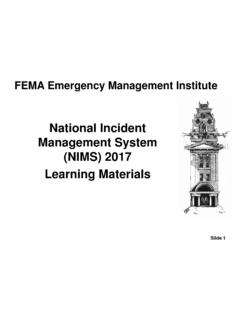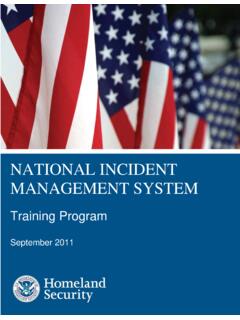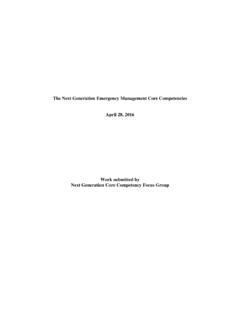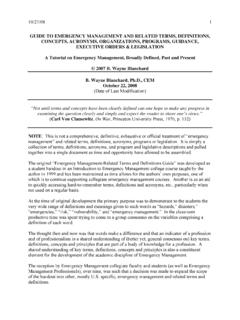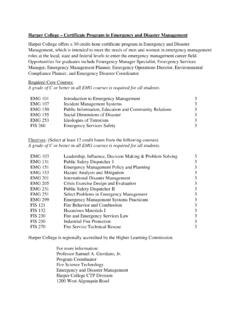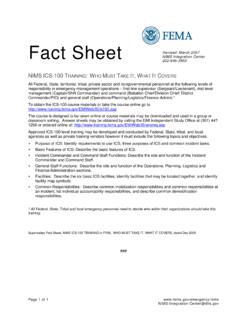Transcription of ICS Review Document - Emergency Management Institute
1 ICS Review Document EXTRACTED FROM - E/L/G 0300 INTERMEDIATE incident COMMAND system FOR EXPANDING INCIDENTS, ICS 300 March 2018 ICS Review Document EXTRACTED FROM - E/L/G 0300 Intermediate incident Command system for Expanding Incidents, ICS 300 2 This page intentionally left blank. March 2018 ICS Review Document EXTRACTED FROM - E/L/G 0300 Intermediate incident Command system for Expanding Incidents, ICS 300 3 Table of Contents national incident Management system .. 5 nims Management Characteristics .. 5 Common Terminology .. 5 Modular Organization .. 6 Management by Objectives .. 6 incident Action Planning .. 6 Manageable Span of Control .. 7 incident Facilities and Locations .. 7 Comprehensive Resource Management .. 7 Integrated Communications .. 7 Establishment and Transfer of Command .. 8 Unified Command .. 8 Chain of Command and Unity of Command .. 8 Accountability.
2 8 Dispatch/Deployment .. 8 Information and Intelligence Management .. 10 ICS History and Features .. 10 incident Command system .. 10 incident Complexity, Complex Incidents and incident Complex .. 10 Position Titles .. 11 ICS Organizational Structure and Elements .. 12 Overall Organizational Functions .. 13 ICS Who Does What? .. 14 incident Commander .. 14 incident Management Team .. 15 Command Staff .. 15 General Staff .. 15 Public Information Officer Responsibilities .. 16 Safety Officer Responsibilities .. 16 Liaison Officer Responsibilities .. 16 Assistants .. 17 March 2018 ICS Review Document EXTRACTED FROM - E/L/G 0300 Intermediate incident Command system for Expanding Incidents, ICS 300 4 Additional Command .. 17 Operations Section Chief Responsibilities .. 17 Planning Section Chief Responsibilities .. 17 Logistics Section Chief Responsibilities .. 18 Finance/Administration Section Chief Resposibilities.
3 19 Intelligence/Investigations Function .. 20 Deputies .. 22 Assistants .. 22 Technical Specialists .. 22 Agency RepresentaMultives .. 23 incident Action Planning Process .. 24 Unified 27 Shared General Staff Sections .. 28 Coordinated Resource Ordering .. 28 Responsibilities of the incident Commander and Unified command .. 29 Authority .. 29 Advantages of Using Unified Command .. 30 Air Operations Branch .. 31 Common Types of Aviation Operations .. 31 Presidential Directives .. 32 ICS Forms .. 33 March 2018 ICS Review Document EXTRACTED FROM - E/L/G 0300 Intermediate incident Command system for Expanding Incidents, ICS 300 5 national incident Management system national incident Management system ( nims ) is the culmination of more than 40 years of efforts to improve interoperability in incident Management . This work began in the 1970s with local, state, and Federal agencies collaborating to create a system called Firefighting Resources of California Organized for Potential Emergencies (FIRESCOPE).
4 FIRESCOPE included ICS and the Multiagency Coordination system (MACS). In 1982, the agencies that developed FIRESCOPE and the national Wildfire Coordinating Group (NWCG) created the national Interagency incident Management system (NIIMS), in part to make ICS guidance applicable to all types of incidents and all hazards. Under Homeland Security Presidential Directive #5 (February 2003), the Federal government created the national incident Management system ( nims ). This system directed the creation of a comprehensive, national approach to incident Management . Recognizing the value of these systems, communities across the Nation have adopted nims . The most current revision of nims was released in October 2017. nims Management Characteristics The following characteristics are the foundation of incident command and coordination under nims and contribute to the strength and efficiency of the overall system .
5 Common Terminology Modular Organization Management by Objectives incident Action Planning Manageable Span of Control incident Facilities and Locations Comprehensive Resource Management Integrated Communications Establishment and Transfer of Command Unified Command Chain of Command and Unity of Command Accountability Dispatch/Deployment Information and Intelligence Management Common Terminology March 2018 ICS Review Document EXTRACTED FROM - E/L/G 0300 Intermediate incident Command system for Expanding Incidents, ICS 300 6 nims establishes common terminology that allows diverse incident Management and support organizations to work together across a wide variety of functions and hazard scenarios. This common terminology covers the following: Organizational Functions: Major functions and functional units with incident responsibilities are named and defined.
6 Terminology for incident organizational elements is standard and consistent. Resource Descriptions: Major resources including personnel, equipment, teams, and facilities are given common names and are typed to help avoid confusion and to enhance interoperability. incident Facilities: incident Management facilities are designated using common terminology. Modular Organization ICS and EOC organizational structures develop in a modular fashion based on an incident s size, complexity, and hazard environment. Responsibility for establishing and expanding ICS organizations and EOC teams ultimately rests with the incident Commander (or Unified Command) and EOC director. Responsibility for functions that subordinates perform defaults to the next higher supervisory position until the supervisor delegates those responsibilities. As incident complexity increases, organizations expand as the incident Commander, Unified Command, EOC director, and subordinate supervisors delegate additional functional responsibilities.
7 Management by Objectives The incident Commander or Unified Command establishes objectives that drive incident operations. Management by objectives includes the following: Establishing specific, measurable objectives; Identifying strategies, tactics, tasks, and activities to achieve the objectives; Developing and issuing assignments, plans, procedures, and protocols for various incident Management functional elements to accomplish the identified tasks; and Documenting results against the objectives to measure performance, facilitate corrective actions, and inform development of incident objectives for the subsequent operational period. incident Action Planning Coordinated incident action planning guides incident Management activities. IAPs represent concise, coherent means of capturing and communicating incident objectives, tactics, and assignments for operational and support activities.
8 March 2018 ICS Review Document EXTRACTED FROM - E/L/G 0300 Intermediate incident Command system for Expanding Incidents, ICS 300 7 Every incident should have an action plan; however, not all incidents need written plans. The necessity for written plans depends on incident complexity, command decisions, and legal requirements. Formal IAPs are not always developed for the initial operational period of no-notice incidents. However, if an incident is likely to extend beyond one operational period, becomes more complex, or involves multiple jurisdictions and/or agencies, preparing a written IAP becomes increasingly important to maintain unity of effort and effective, efficient, and safe operations. Staff in EOCs also typically conduct iterative planning and produce plans to guide their activities during specified periods, though these are typically more strategic than IAPs. Manageable Span of Control Maintaining an appropriate span of control helps ensure an effective and efficient incident Management operation.
9 It enables Management to direct and supervise subordinates and to communicate with and manage all resources under their control. The type of incident , nature of the task, hazards and safety factors, experience of the supervisor and subordinates, and communication access between the subordinates and the supervisor are all factors that influence manageable span of control. The optimal span of control for incident Management is one supervisor to five subordinates; however, effective incident Management frequently necessitates ratios significantly different from this. The 1:5 ratio is a guideline, and incident personnel use their best judgment to determine the actual distribution of subordinates to supervisors for a given incident or EOC activation. incident Facilities and Locations Depending on the incident size and complexity, the incident Commander, Unified Command, and/or EOC director establish support facilities for a variety of purposes and direct their identification and location based on the incident .
10 Typical facilities include the incident Command Post (ICP), incident base, staging areas, camps, mass casualty triage areas, points-of-distribution, and Emergency shelters. Comprehensive Resource Management Resources include personnel, equipment, teams, supplies, and facilities available or potentially available for assignment or allocation. Maintaining an accurate and up-to-date inventory of resources is an essential component of incident Management . Section II, the Resource Management component of this Document , describes this in more detail. Integrated Communications Leadership at the incident level and in EOCs facilitates communication through the development and use of a common communications plan, interoperable communications processes, and systems that include voice and data links. Integrated March 2018 ICS Review Document EXTRACTED FROM - E/L/G 0300 Intermediate incident Command system for Expanding Incidents, ICS 300 8 communications provide and maintain contact among and between incident resources, enable connectivity between various levels of government, achieve situational awareness, and facilitate information sharing.
